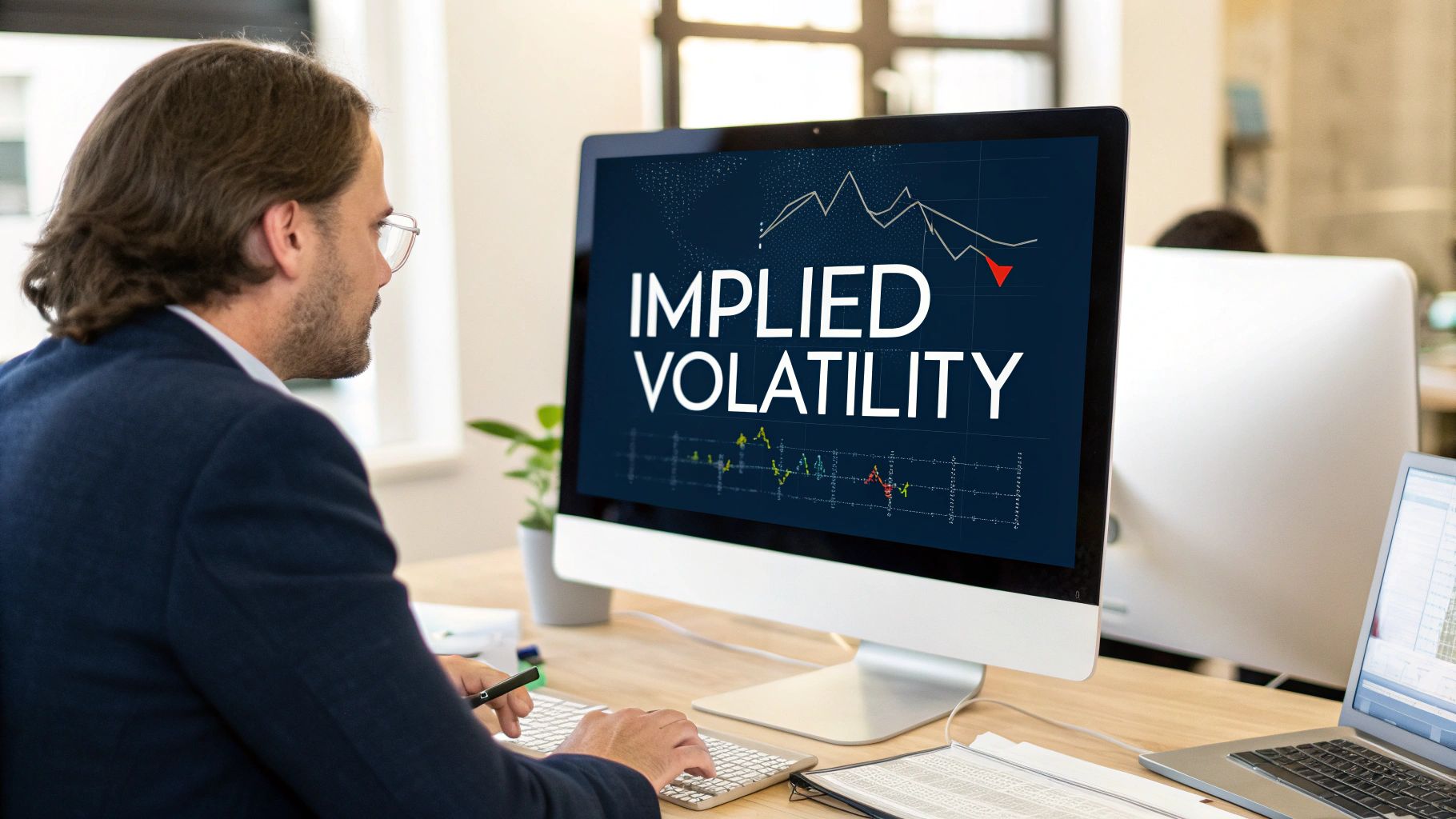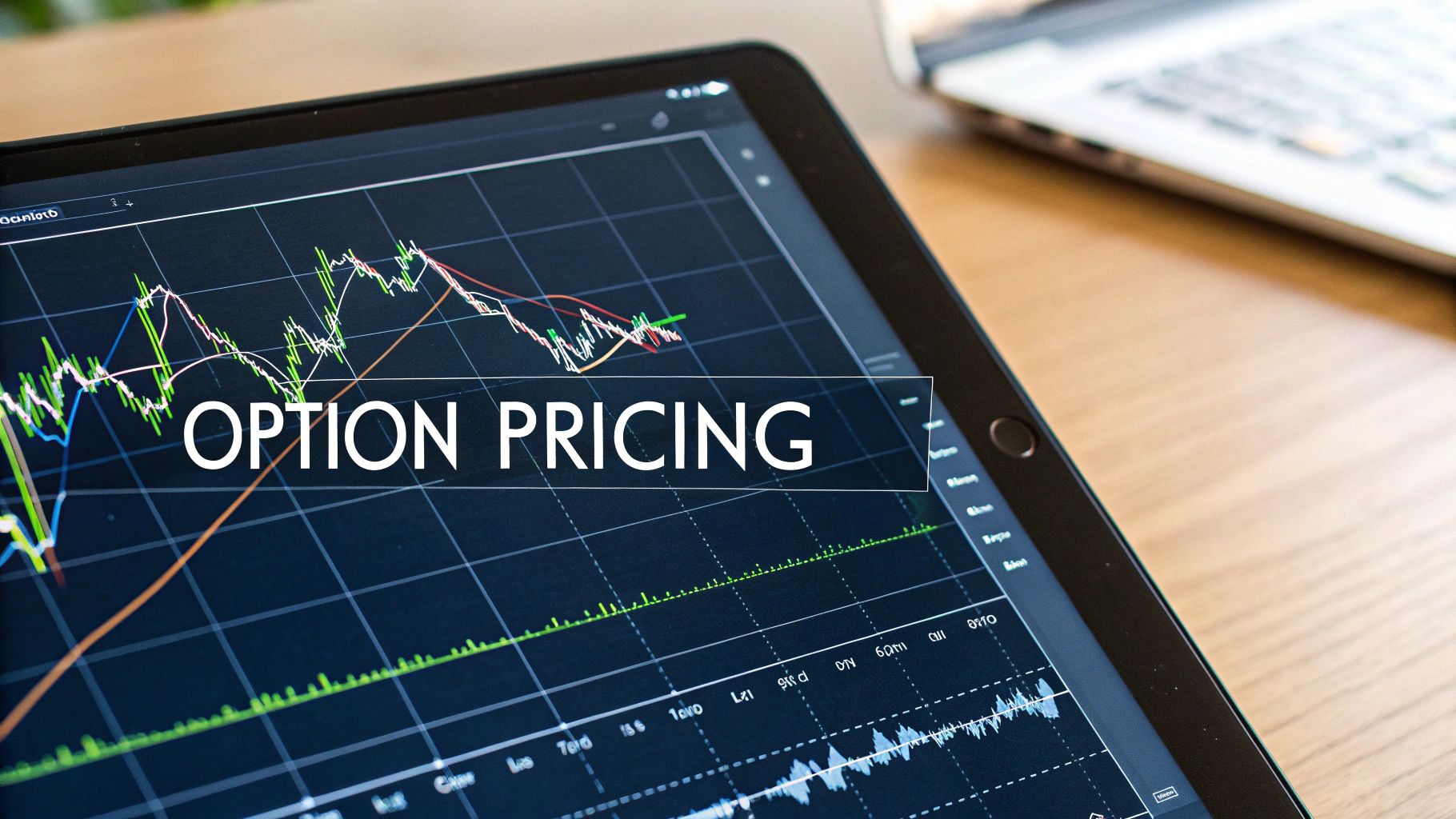Demystifying Implied Volatility: What Smart Traders Know

Traders often call implied volatility the "market's fear gauge" because it shows how much the market expects prices to move. While this metric might seem complex at first, understanding how to read and apply implied volatility can significantly improve your options trading results. Let's break down what really matters about this key concept.
Why Implied Volatility Matters
Think of implied volatility like an insurance premium – when there's more uncertainty, prices go up. When you're trading options, higher implied volatility means you'll pay more for contracts. Just as insurance costs more before hurricane season, option prices increase when markets expect bigger price swings. This direct relationship between implied volatility and option prices makes it essential to understand before placing any trades.
How Professional Traders Use Implied Volatility
Experienced traders watch implied volatility for early warning signs of market moves. For example, when implied volatility jumps but the stock price hasn't moved much yet, it often means traders are expecting big news or events soon. Smart traders use these signals to position themselves ahead of time. They also compare implied volatility levels between different options to find good deals – buying options when they're cheap and selling them when they're expensive.
Common Misconceptions About Implied Volatility
Many newer traders think high implied volatility always means a stock is dangerous to trade. That's not quite right – high implied volatility just means there's more uncertainty, often around events like earnings reports. This uncertainty can actually create good trading opportunities. Another mistake is assuming implied volatility tells you which way prices will move. It only shows how big the expected move is, not whether prices will go up or down. This means you can profit from implied volatility in either direction.
Incorporating Implied Volatility into Your Strategy
You don't need complex math to use implied volatility in your trading. Simply tracking how implied volatility changes on your favorite stocks can help you make better decisions. For instance, when selling covered calls, higher implied volatility means you can collect bigger premiums – but you'll want to be extra careful about picking strike prices. If you're buying protective puts, watching implied volatility helps you avoid overpaying for insurance. Start by noting implied volatility levels when you place trades, and soon you'll develop a feel for what's normal versus unusual for your chosen stocks.
Making Sense of the Volatility Smile

Once you understand the basics of implied volatility in options trading, you'll notice an interesting pattern called the volatility smile. This name comes from the curved shape that appears when you plot implied volatility against different strike prices for options that share the same expiration date and underlying asset. Rather than forming a straight line, the graph curves upward at both ends, creating a smile-like shape. This tells us that out-of-the-money (OTM) options, both puts and calls, typically show higher implied volatility compared to at-the-money (ATM) options.
Unpacking the Reasons Behind the Smile
The smile shape reflects how traders view market risk and extreme price movements. Market participants often expect bigger price swings than standard models predict. Consider deep OTM put options – these become profitable when prices fall sharply, making them popular as protection against market crashes. This strong demand for downside protection pushes up their implied volatility and price. On the flip side, deep OTM call options may also show high implied volatility as traders factor in the possibility of sudden price jumps from unexpected market news or events.
Identifying Opportunities Within the Smile
Smart traders can spot chances to profit by studying these volatility patterns. By comparing the implied volatility of different options to their historical volatility levels, you can find options that may be incorrectly priced. For example, if you notice a far OTM put option showing much higher implied volatility than its historical pattern suggests, you might consider selling that option. This strategy assumes the market is overestimating the chances of a big price drop. However, keep in mind that such trades come with their own set of risks.
Trading the Volatility Smile: Strategies and Risks
To trade the volatility smile effectively, you might sell OTM options that seem expensive or buy options near the money where volatility appears lower. Take SBI options as an example – if you see a steep smile around the 225 strike price, you could sell far OTM puts and calls to benefit from their high implied volatility. Another approach is buying options closer to the ATM strike price, betting that the smile's steepness will decrease. But remember, these strategies aren't without danger. Selling options can lead to major losses if prices move strongly against your position. While buying options limits your potential loss to the premium paid, you need to correctly predict both market direction and timing to make money. The volatility smile offers useful insights, but success depends on fully understanding both its patterns and the risks involved.
Mastering Market Events and Volatility Shifts

We've covered the basics of options implied volatility and patterns like the volatility smile. Now let's examine how specific market events affect implied volatility and create trading opportunities. Understanding these relationships helps traders spot and act on profitable setups while managing risk.
Earnings Announcements: A Volatility Catalyst
Company earnings reports reliably drive changes in options implied volatility. As earnings day approaches, uncertainty builds about the upcoming numbers, pushing implied volatility higher for that company's options. Take a typical tech stock – its options might show 20-25% implied volatility normally, but spike to 40% or more right before earnings. After the announcement, that elevated volatility usually drops sharply as uncertainty clears. Smart traders watch for and plan around this predictable pattern.
Economic Releases and News Events: Riding the Volatility Wave
Major economic reports and unexpected news also move implied volatility across markets. When key data like jobs numbers or inflation figures come out, options prices often jump market-wide as traders brace for potential swings. Sudden news – whether political developments or industry shake-ups – can spike volatility in specific sectors too. During the 2008 crisis, implied volatility soared as traders scrambled to protect positions amid extreme uncertainty. These volatile periods mean higher options premiums, creating opportunities for prepared traders.
Anticipating Volatility Shifts: A Proactive Approach
Rather than just reacting to volatility spikes, experienced traders work to anticipate them. They track implied volatility trends leading up to known events and compare current levels to historical patterns. This helps spot options that look mispriced relative to likely volatility changes ahead. For instance, if earnings-related volatility typically rises more than current prices suggest, buying options early could pay off. It's like getting insurance before a storm – costs less beforehand and provides protection when needed.
Managing Risk During High-Volatility Periods: Protecting Your Capital
While volatile markets offer profit potential, they demand careful risk management. Successful traders use several key approaches:
- Diversification: Spreading trades across different sectors and asset types to avoid concentrated exposure
- Position Sizing: Keeping individual trade sizes modest relative to account size
- Hedging: Using protective strategies like married puts to limit downside
These methods help traders handle volatility's challenges while capturing its opportunities. With proper planning and risk controls, implied volatility becomes a valuable edge rather than a threat to trading success.
options implied volatility section rewritten with a natural flow and style:
Understanding the Math Without Losing Your Mind

At first glance, calculating implied volatility might seem like rocket science. But here's the good news – you don't need a PhD in mathematics to grasp the essential concepts that matter for real-world trading. Let's break down what you actually need to know and what you can comfortably leave to your trading software.
Focusing on the Practical Calculations
The Black-Scholes model forms the foundation for implied volatility calculations, but you can use it effectively without diving into complex formulas. The model considers five main components: option price, underlying asset price, strike price, time until expiration, and risk-free interest rate. Implied volatility emerges as the missing piece that makes the equation work. For instance, when you input the known variables, the model reveals the implied volatility that's built into the current option price. Most modern trading platforms handle these calculations automatically, letting you focus on the implications rather than the math.
What You Need to Know About the Black-Scholes Model
Instead of getting lost in formulas, focus on understanding how different factors influence implied volatility. When an option's price goes up while other factors stay constant, implied volatility typically rises too. Time plays a similar role – longer expiration dates usually mean higher implied volatility since there's more time for significant price movements. Consider a simple example: a stock has more room to make big moves over six months compared to just one week.
Simplifying Implied Volatility Interpretation
After your trading platform calculates implied volatility, the real work begins in understanding what the number means for your trades. Take a stock with 30% implied volatility – this suggests the market expects price movements of about 30% up or down over the next year (within one standard deviation). The direction isn't predicted, just the magnitude of potential movement. Market events can shake things up quickly – for example, a typical tech stock's implied volatility might hover around 20-25% normally but jump to 40% or higher just before earnings announcements.
Using Implied Volatility to Your Advantage
Monitor implied volatility trends across different options on the same stock to spot potential trades. When implied volatility spikes unusually high, you might find opportunities to sell options at premium prices. Conversely, unusually low implied volatility could signal good buying conditions. Compare implied volatility against the stock's historical volatility to gauge whether market reactions seem excessive or muted. Look for mismatches – situations where implied volatility appears out of line with the stock's typical behavior. These disparities often point to trading opportunities that you can act on with confidence, adding another valuable tool to your trading approach.
Building Your Volatility Trading Arsenal
After covering the basics of implied volatility and understanding how it shapes market behavior through the volatility smile, let's focus on putting this knowledge to work with real trading strategies. We'll explore specific approaches that work well in both high and low volatility conditions, including clear guidelines for entering and exiting trades. Most importantly, we'll look at how to protect your capital through smart risk management.
Strategies for High Implied Volatility
When market events like earnings reports approach, implied volatility often spikes as traders expect bigger price swings. Think of it like insurance premiums rising before a potential storm – you don't know which direction the storm will move, but you know it's likely coming.
-
Short Strangles/Straddles: By selling both call and put options on the same asset, you can profit from overpriced options premiums. For example, if a stock trading at $100 has unusually expensive options before earnings, you might sell both the $95 put and $105 call to collect premium. But remember – this strategy needs careful management since losses can mount quickly if the stock makes a large move.
-
Iron Condors: This strategy offers better protection than naked strangles. You create a range where you profit by selling a put spread and a call spread together. While the potential profit is smaller than with short strangles, your risk is strictly limited to the width between your strikes minus the premium received.
Strategies for Low Implied Volatility
Quiet market periods require different tactics to generate profits from options trading.
-
Calendar Spreads: These work especially well in low volatility environments. The approach involves selling near-term options while buying longer-dated ones at the same strike price. As the short-term option decays faster, you profit even if the stock stays flat. This strategy becomes even more profitable if volatility increases while you hold the position.
-
Long Strangles/Straddles: When options are cheap due to low implied volatility, buying both calls and puts can pay off nicely if prices start moving. This strategy works best when you spot signs that the market's calm might soon end, like before major product announcements or economic reports.
Adapting to Changing Markets and Managing Risk
Markets never stay the same for long, so successful options traders stay flexible and prioritize protecting their capital above all else.
-
Monitoring and Adjustment: Keep track of implied volatility levels compared to their typical ranges for stocks you trade. When you notice unusual patterns – like implied volatility sitting well below normal before a typically volatile event – that's often your signal to act. Tools like TradingView can help track these patterns.
-
Position Sizing and Stop Losses: Smart traders never risk more than 1-2% of their account on a single trade. They also set clear exit points before entering positions. For example, you might decide to close a short strangle if losses reach 50% of the maximum premium received.
Identifying High-Probability Setups
The best trading opportunities often appear when multiple factors line up together. Look for situations where implied volatility readings are unusual compared to historical patterns, especially when combined with upcoming events that could move the stock.
Remember that successful options trading isn't about hitting home runs – it's about consistently making good decisions based on solid analysis and always protecting your downside. By measuring implied volatility against historical norms and maintaining strict risk controls, you can use these strategies to build a sustainable edge in the options market.
Advanced Volatility Concepts That Matter
To become a skilled options trader, you need to understand more than just basic implied volatility. The most successful traders look deeper, combining several analytical approaches to spot hidden opportunities in the market. Let's explore some key advanced concepts that can give you better insights into market behavior.
Volatility Surface Analysis: A Multi-Dimensional View
Think of a volatility surface as a 3D map showing how implied volatility changes across different strike prices and expiration dates. This visual tool reveals patterns that a single volatility number can't show. For instance, when out-of-the-money options show much higher implied volatility than at-the-money options, creating a steep surface, it often signals that traders expect big price moves ahead. In contrast, a flatter surface typically means the market expects calmer conditions. By studying these patterns, you can better spot options that may be incorrectly priced and adjust your trading decisions accordingly.
Term Structure of Volatility: Riding the Curve
The term structure shows how implied volatility differs across time periods, similar to how interest rates vary with different maturities. Sometimes you'll see an "inverted" structure, where short-term options have higher implied volatility than longer-term ones – this often happens right before major events like earnings reports. Other times, you'll see a "normal" structure, with higher volatility in longer-term options, showing growing uncertainty over time. This knowledge helps you plan trades around specific events. For example, if you expect volatility to drop after an earnings announcement, you might sell short-term options beforehand to profit when their prices fall.
Correlation and Volatility: Untangling Interconnected Markets
Understanding how different assets move together is key when trading multiple positions. Two stocks with high positive correlation tend to move in sync, and their implied volatilities often respond to the same market forces. But these relationships aren't fixed – they change as market conditions shift. This matters because market events can create chain reactions in volatility. For example, a sudden oil price drop might first hit energy stocks but then spread anxiety across the broader market, pushing up implied volatility in many sectors. Knowing these connections helps you protect your positions and find new opportunities.
Gain an edge in options trading with Coverd, the app designed to streamline your covered call and cash-secured put strategy. Turn tedious manual research into valuable insights in seconds. Boost your portfolio returns while mitigating risk. Learn more at https://coverd.io.

Leave a Reply